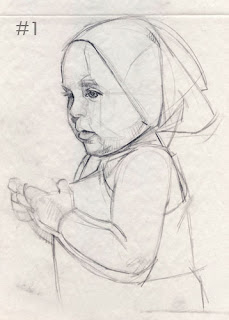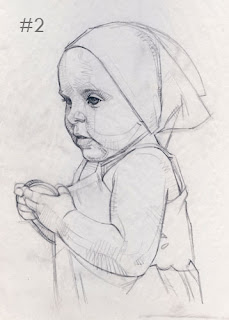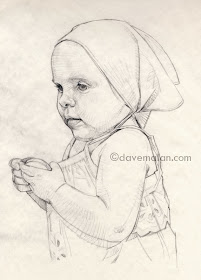step #1 - Get a pad of tracing paper. Set it up on an easel or whatever, close to a photo/model that you want to draw.
step #2 - Draw the subject. Try to do as much measuring as you can. Measure the distance between features with a straight object. Stand at least arms length, close an eye, hold your arm straight and use the end of the pencil and your finger (this is a useful technique for life drawing too). You'll get something fairly rough.
 step #3 - Now step back and squint you should be able to see some structural problems. Tear off the drawing and put it underneath the next page and trace only the correct lines. Next, pull away the drawing #1.
step #3 - Now step back and squint you should be able to see some structural problems. Tear off the drawing and put it underneath the next page and trace only the correct lines. Next, pull away the drawing #1.step #4 - Now you've cleaned out a bunch of messy measurement lines. With the new simplified lines as a base, re-draw the subject. You should get closer this time around. Continue to step back and squint to find all the problems.
 step #5 - Repeat 4-5 times.
step #5 - Repeat 4-5 times. Now this is never intended to be a nice finished drawing and it's not beautiful, but it should help get you closer and closer to accuracy with each iteration, you can transfer it to good paper and do a nice drawing or use it for a painting.
Now this is never intended to be a nice finished drawing and it's not beautiful, but it should help get you closer and closer to accuracy with each iteration, you can transfer it to good paper and do a nice drawing or use it for a painting.You are learning to see. Most people can handle a pencil just fine but seeing where a line should be is much more difficult and takes a lot of practice. Another very important trick for drawing is putting a line down. It doesn't have to be right just put something there and you can then use that line as a fixed point to decide it you are too low/high/long/short/left/right.
This is the basic measuring process I use for every drawing but all together at once on one page and without the tracing paper. This method is just a good way to break it down and take a more analytical approach which helps with learning and makes problems more apparent.
Awesome!!!!! Thanks for sharing this process!!!
ReplyDeleteWhen you mention measure...are you talking about measuring the distance of features? With a ruler, or pencil with markings?
Yes, distance between features with a straight object, stand at least arms length close an eye, hold your arm straight and use the end of the pencil and your finger. (this will be a usable technique for life drawing too).
ReplyDeleteGood word David. This will be very helpful to me and my students. Thanks for sharing.
ReplyDeleteWonderful technique! Thanks!
ReplyDeleteThank you for taking the time to share this information! I will definitely try it out.
ReplyDeleteThis type of drawing is a normal procedure of teaching in my country (Poland), so i did not find it very innovative also because in this way academies of fine arts close students to be innovative. They are all very similar. Michelangelo measured everythig by his eye and mind, that'a a genius! I'm annoied with this method. But I also try to find different results than you. Anyway you are very good in what you are doing. Good luck.
ReplyDeleteGreat stuff, Dave. Nice to see this technique that you've suggested to me in action.
ReplyDeleteThanks for this!
ReplyDeleteYou mention that you use this technique on a single sheet of paper. At this stage, how many 'generations' do you go through? What kind of paper are you using in that case?
Steve, I meant a single sheet for each stage. then I'll go through 4-5 sheets in the end with hopefully each of them being better then the previous. All are done on tracing paper.
ReplyDeleteThanks!
ReplyDeleteGreat reads!